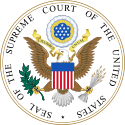- Class Action Fairness Act of 2005
-
Class Action Fairness Act of 2005 
Full title An Act to amend the procedures that apply to consideration of interstate class actions to assure fairer outcomes for class members and defendants, and for other purposes. Enacted by the 109th United States Congress Citations Public Law Pub.L. 109-2 Stat. 119 Stat. 4–14 Codification - Introduced in the Senate as S. 5 by Chuck Grassley on January 25, 2005
- Committee consideration by: Senate Judiciary
- Passed the Senate on February 10, 2005 (72–26)
- Passed the House on February 17, 2005 (279-149)
- Signed into law by President George W. Bush on February 18, 2005
Major amendments Relevant Supreme Court cases The U.S. Class Action Fairness Act of 2005, 28 U.S.C. Sections 1332(d), 1453, and 1711–1715, expanded federal jurisdiction over many large class-action lawsuits and mass actions taken in the United States.
The bill was the first major piece of legislation of the second term of the Bush Administration. Business groups and tort reform supporters had lobbied for the legislation, arguing that it was needed to prevent class-action lawsuit abuse.[1] President George W. Bush had vowed to support this legislation.
The Act gives federal courts jurisdiction to certain class actions in which the amount in controversy exceeds $5 million, and in which any of the members of a class of plaintiffs is a citizen of a state different from any defendant, unless at least two-thirds or more of the members of all proposed plaintiff classes in the aggregate and the primary defendants are citizens of the state in which the action was originally filed. The Act also directs the Courts to give greater scrutiny to class action settlements, especially those involving coupons.
Contents
Support
The Act accomplished two key goals of tort reform advocates:
- Reduce "forum-shopping" by plaintiffs in friendly state courts by expanding federal diversity jurisdiction to class actions where there is not "complete diversity" giving federal jurisdiction over class actions against out-of-state defendants. Proponents argued that "magnet jurisdictions" such as Madison County, Illinois were rife with abuse of the class action procedure.
- Requires greater federal scrutiny procedures for the review of class action settlements and changes the rules for evaluating coupon settlements, often reducing attorney's fees that are deemed excessive relative to the benefits actually afforded class members. For example, in an infamous Alabama class action involving Bank of Boston, the attorneys' fees exceeded the relief to the class members, and class members lost money paying attorneys for the "victory."[2]
Republicans supported the act in that only one Republican member of Congress (John Doolittle of California) voted against it, and a Republican president signed it.

United States Federal
Civil Procedure DoctrinesJusticiability Advisory opinions Standing · Ripeness · Mootness Political questions Jurisdiction Federal question jurisdiction Diversity jurisdiction Supplemental jurisdiction Removal jurisdiction Amount in controversy Class Action Fairness Act of 2005 - Personal jurisdiction:
In personam In rem jurisdiction Quasi in rem jurisdiction Federalism Erie doctrine · Abstention Sovereign immunity · Abrogation Rooker-Feldman doctrine Adequate and
independent state groundedit this template Critics
Critics charged that the legislation would deprive Americans of legal recourse when they were wronged by powerful corporations. Congressman Ed Markey (D-Mass.) called the bill "the final payback to the tobacco industry, to the asbestos industry, to the oil industry, to the chemical industry at the expense of ordinary families who need to be able go to court to protect their loved ones when their health has been compromised."[2]
Critics charge that this bill makes it far more difficult to bring class action suits, and may prolong such litigation, clogging the federal courts' dockets. The act also gives the federal government some ability to control, through judicial appointments, outcomes that were previously under state control.[citation needed]
Critics argue that the expansion of federal jurisdiction comes at the expense of state's rights and federalism, something that Republicans have historically protested; however, proponents respond that the bill is consistent with the founders' original intent for the role of federal courts and diversity jurisdiction expressed by Alexander Hamilton in Federalist No. 80.[citation needed]
Impact
A study by researchers at the Federal Judicial Center has found that the enactment of CAFA was followed by an increase in the number of class actions filed in or removed to the federal courts based on diversity jurisdiction. This finding is consistent with the congressional intent in enacting CAFA. The observed increase was due primarily to increases in consumer class actions. Somewhat surprisingly, the FJC study found that much of the increase in diversity class actions has been driven by an increase in original filings in federal courts. This finding suggests that plaintiffs' attorneys are choosing the federal forum, post-CAFA, rather than defendants' counsel through removal, contrary to expectations.[3]
See also
References
- ^ Branigan, William (2005-02-17). "Congress Changes Class Action Rules". Washington Post. http://www.washingtonpost.com/wp-dyn/articles/A32674-2005Feb17.html. Retrieved 2008-09-07.
- ^ a b 7th Circuit, US Court of Appeals (2003). "Kamilewicz v Bank Of Boston". New York Times. http://caselaw.lp.findlaw.com/scripts/getcase.pl?navby=search&case=/data2/circs/7th/961019.html&friend=nytimes. Retrieved 2008-09-07.
- ^ Lee, Emery G.; Willging, Thomas E. (April 2008). "The Impact of the Class Action Fairness Act of 2005 on the Federal Courts" (PDF). Federal Judicial Center. http://www.fjc.gov/public/pdf.nsf/lookup/cafa0408.pdf/$file/cafa0408.pdf. Retrieved 2008-09-07.
Further reading
- Salon: "Erin Brockovich, drop dead"
- American Law Media: "A Class Act"?
- "They’re Making a Federal Case Out of It ... In State Court" Manhattan Institute, Issue #3, September 2001
- "$5 million Class Action Controversy?--Go to Federal Court", Court Watch, November 8, 2005 (Also, links to the Act)
- Kamilewicz v. Bank of Boston Corp., 100 F.3d 1348 (7th Cir. 1996)
- "Understanding the Class Action Fairness Act of 2005", Prof. William Rubenstein, UCLA School of Law
- "CAFA and Erie: Unconstitutional Consequences?", Note, Fordham Law Review, November 2006
- Emery G. Lee III & Thomas E. Willging, The Impact of the Class Action Fairness Act of 2005 on the Federal Courts (FJC, April 2008)
- "A Step Up in Class," ABA Journal, May 2008
- "CLASS ACTION REFORM: WILL PERCEPTION BECOME REALITY"
External links
Categories:- Jurisdiction
- United States federal judiciary legislation
- 2005 in law
- 2005 in the United States
- 109th United States Congress
Wikimedia Foundation. 2010.
